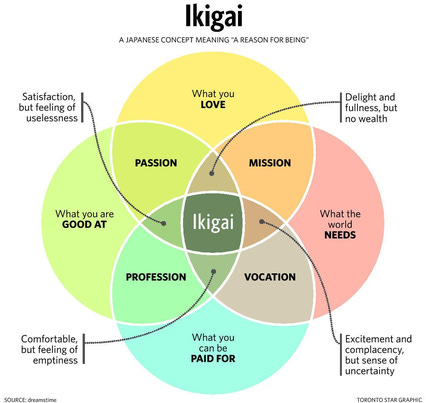5 steps to find your interests as an adult
"So, do you like stuff?"
When I was 7, I remember watching Agro’s Cartoon Connection, when a Scoutmaster came on to talk about all the things you can do in Scouts.
Games, camping and - wait for it - tying knots. Wild stuff.
Obviously I couldn’t resist the siren song of knot tying. I thought, “that looks cool, I want to join.
Back then, I’d dive into new things with reckless abandon, full of enthusiasm and no concept of failure.
Some things stuck, some didn’t, but none of it mattered. I was just happy to give everything a go.
But as I got older, things changed.
Suddenly, trying new things didn’t feel so carefree anymore.
The stakes were higher - I had less time, even less energy and my parents weren’t footing the bill.
Plus, the fear of failing or picking the wrong thing, or worrying about what other people thought, started to pile on.
It was like having 1,000 different voices in my head, all saying “give up”, before actually starting anything.
And before I knew it, I was living the same week over and over.
Same job, same meals, same house, same routine, same group chats, same TV reruns (not Agro’s Cartoon Connection).
Does this sound familiar?
A lot of people get stuck in this loop because it’s tough to find new interests as an adult.
But there is a way out - a simple system that helped me get a bit of direction.
I must preface this by acknowledging this is not the only way to go about this — and maybe it’s not even the best way! But it worked for me so I wanted to share it:
Step 1: Do a bit of self-exploration
The Japanese have this concept called Ikigai, which translates to “reason for being”.
Basically it’s about finding the sweet spot in life by asking yourself:
What do I love?
What am I good at?
What can I get paid for?
What does the world need?
Map these out into 4 overlapping circles like so:

There are four intersections on the chart:
Passion (What you love + What you’re good at)
Mission (What you love + What the world needs)
Vocation (What the world needs + What you can be paid for)
Profession (What you’re good at + What you can be paid for)
Finally, at the centre where all four circles overlap is your Ikigai.
Now, most people will read this and do nothing. They won’t get a pen and paper and list out their 4 things.
They’ll say, ‘wow Ikigai, cool word,’ then keep scrolling. At least that’s what I did the first few times I heard about it.
But then I took the small step and mapped mine out:
Despite the illegible font, it gave me a lot more clarity on a way forward.
If you’re the type who actually reads things and then implements them, you’re already ahead.
If you manage to find your Ikigai right off the bat, please let me know because I need to subscribe to your newsletter. Because for the rest of us, it’s a process of trial and error.
As you work through it, you’ll see that the magic lies in the overlapping areas.
If you’re doing something you love AND getting paid for it, the more likely you are to stick with it.
Or if you’re working on something you’re good at and the world actually needs, then you’re way less likely to bail when things get tough.
When all the right pieces fall into place, it doesn’t feel like a constant uphill battle – it feels like, “Oh, this is where I’m supposed to be.”
Step 2: Try new things without judgement
Okay, so now you’ve got your list.
It’s exciting, but also a little terrifying, right?
This is probably where the anxiety kicks in, and if we’re being honest, it’s why you haven’t acted on it yet.
I’ve written newsletters about this before:
Feel free to go back and read them, or maybe you just want to subscribe.
A new trick I’ve learned is to reframe your tasks as experiments.
Why? Because it takes the pressure off.
It’s not about success or failure anymore - it’s about the effort.
The process of trying becomes just as valuable as the result.
So, when you’re starting your list, treat it like data collection.
Set yourself a time frame and a number of things you want to try. For example, “I’m going to try one new thing every week for 3 months.”
Make sure it’s practical and doesn’t turn into procrastination. Because if you’re anything like me, a million new interests will morph into a million different excuses not to focus on one.
Step 3: Reflect on what resonates
There’s this old Chinese proverb: “The faintest ink is stronger than the greatest memory.”
Clearly, whoever said this hadn’t used cloud storage, but the point stands - you need to track your experiments by writing things down.
After each experiment, jot down some thoughts. Ask yourself:
Did I enjoy this?
Did it give me energy or drain me?
Would I want to explore this further?
Rate each experience on a scale of fulfilment or enjoyment..
This will help you figure out what you actually like and what just seems cool in theory.
Like minimalism or joining the Scouts.
Step 4: Narrow it down
Now, picture this:
You’re standing at the counter at Messina. I’d say Yo-Chi if I ever thought it was possible to make it to the counter.
You’ve asked to try the Boysenberry, the Dulce de Leche and whatever special flavour they’re offering that week. Y’know, the one with pun-tastic name riddled with sexual innuendo.
You’ve accumulated enough tiny plastic spoons to kill an endangered sea turtle.
The line behind you is getting restless.
It’s time to choose.
If this analogy is shit it’s because I’m lactose intolerant and low-key dirty on anyone who gets to choose more than sorbets at Messina.
But the point I’m trying to make is after a series of experiments, it’s time to narrow down your top interests by asking yourself:
Which interests did I enjoy the most?
What do I want to keep exploring?
What kept drawing me in?
The goal is to walk away with a shortlist of 1-2 things you feel genuinely excited about.
And remember you don’t have to do it all at once. You’re not going to miss out. If you pick one path now, you can always try something else later.
Except maybe not the Cuck Coconut.
Step 5: Carve out the time to act
It’s one thing to have a new interest or goal. It’s another to have a plan in place to bring it to life.
First, figure out how much time you can realistically dedicate. If you’ve got five hours a week to spare, fantastic!
Plan it. Block it out. Protect it at all costs.
Last week, I wrote about how all those tiny, seemingly inconsequential decisions chip away at your mental bandwidth.
So, by setting a fixed time – like 7am every Tuesday – you’re taking decision fatigue off the table.
You don’t have to debate yourself. You already know what you’re meant to be doing and when you’re meant to be doing it.
You can’t rely on motivation. Trying to get ahead through self-discipline leaves too much to chance.
In conclusion: Take the first step
Now all that’s left is to start.
Remember, you don’t have to tackle everything at once. Just pick one path for now, and give it your attention. You can always switch lanes later.
The goal here isn’t perfection, it’s progress.
Even if it’s messy, even if you second-guess yourself along the way, you’re still miles ahead of where you were when you had no idea what your interests were.







love it Andy - the curious blending of insight with intelligent humour - you keep nailing it
One of the best articles and certainly a great fascinating exercise